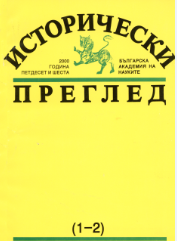Структура на аграрното и социалното пространство в селото на Балканите през втората половина на XVII в.: районът на Одрин в 1669 г.
Structure of the Agrarian and Social Space in the Villages in the Balkans during the Second Half of the 17th Century. The Adrianople Area in 1669
Author(s): Stefka ParvevaSubject(s): History, Economic history, Social history, Modern Age, Special Historiographies:, 17th Century, The Ottoman Empire
Published by: Институт за исторически изследвания - Българска академия на науките
Keywords: Adrianople; Ottoman Empire; reaya; askers; ciftlic lands
Summary/Abstract: On the basis of Ottoman registers, unique for their information, of nine villages and one mezraa n the area of Adrianople of 1669, the authoress tries to analyse the forms and degree of utilizing and organizing farm land at the level of that of a village as a whole and of the individual household in particular; to reconstruct the picture of property differentiation between the two groups of village inhabitants – reaya and askers; to look for the links between the economic conditions and the behaviour of the peasants with respect to the land and farm production. The analysis of the data permits the following conclusions to be drawn. In the first place, in the area studied is observed a comparatively high degree of utilizing the land suitable for farming. In individual cases even the maximum of the capacity of the village lands was reached. In the second place is noticed a marked activity of the peasants in the process of obtaining land of which the village was short or additional, probably more fertile areas suitable for cultivation within the framework laid down by the law. With respect to the organization of farm production is observed as a whole the prevalence of the three-stage system of crop-rotation, but at the same time in individual reaya farms ciftlic lands, even in whole villages, the two-stage system of crop-rotation was still applied. The nomenclature of agricultural productions, outline by the inheritance of the Adrianople “askers” shows that the principal crop cultivated in the region was wheat, followed by rye, barely and millet. As additional but well-represented occupation in some villages (Mihalich, Karaagach) was viticulture and respectively win-making. Only in one of the cases (Karaagach), influenced no doubt by the proximity of the town, is observed the setting aside of plots of the village land for the growing of vegetables, fruit and for hay. Notwithstanding the suitable soil and weather conditions in the region, in the 17th c., probably due to imperial prohibition, no tobacco was grown. In the third place, the villages researched show an advanced property differentiation among the village inhabitants in the reaya category. Thais makes the authoress to assume that in the sphere of the agrarian economy existed stimuli from which benefited individual village producers, irrespective of their religious or ethnic belonging. They formed that thin layer of well-to-do peasants who could afford the accumulation and farming of land several times over the dimensions of the reaya ciftlic allowed by the law. In the next place, the sources used are yet another proof of the interest on the part of the representatives of the ruling class in investing capital in plant growing and livestock breeding farms. The data point out that the process of differentiation of plots from the village land into ciftliks was fairly advanced; in the individual villages of the region studied they came up to 53% of the cultivated area, and in some places probably more. This process plots not only from the State fund but also such as belonged to the vakifs. At the same time, however, the summed-up data on the cultivable lands in the nine villages as a total territory show that reaya ciftlics constituted 74% of it and the estates of representatives of the group of the “askers” 26% This is yet another proof that the peasant continued to be the basic producer and land owner. Precisely his economic activity was the basis of supplying farm products to the big consumers, the markets and export. Although the interference of the representatives of the ruling class in agricultural production was obvious, the principles of the agrarian system in the Empire at the foundation of which stood the reays ciftlik, were not discredited.
Journal: Исторически преглед
- Issue Year: 2000
- Issue No: 1-2
- Page Range: 22-82
- Page Count: 61
- Language: Bulgarian
- Content File-PDF

